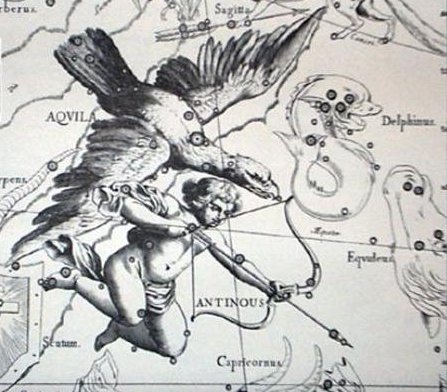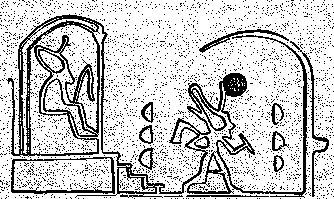90. We must not forget the Chinese wooden clappers: ... In China, every year about the beginning of April, certain officials called Sz'hüen used of old to go about the country armed with wooden clappers. Their business was to summon the people and command them to put out every fire. This was the beginning of the season called Han-shih-tsieh, or 'eating of cold food'. For three days all household fires remained extinct as a preparation for the solemn renewal of the fire, which took place on the fifth or sixth day after the winter solstice [Sic!]. The ceremony was performed with great pomp by the same officials who procured the new fire from heaven by reflecting the sun's rays either from a metal mirror or from a crystal on dry moss. Fire thus obtained is called by the Chinese heavenly fire and its use is enjoined in sacrifices: whereas fire elicited by the friction of wood is termed by them earthly fire, and its use is prescribed for cooking and other domestic purposes ... Like archaic China and certain Amero-Indian societies, Europe, until quite recently, celebrated a rite involving the extinguishing and renewal of domestic fires, preceded by fasting and the use of the instruments of darkness. This series of events took place just before Easter, so that the 'darkness' which prevailed in the church during the service of the same name (Tenebrae), could symbolize both the extinguishing of domestic fires and the darkness which covered the earth at the moment of Christ's death. In all Catholic countries it was customary to extinguish the lights in the churches on Easter Eve and then make a new fire sometimes with flint or with the help of a burning-glass. Frazer brings together numerous instances which show that this fire was used to give every house new fire. He quotes a sixteenth-century Latin poem in a contemporary English translation, from which I take the following significant lines: On Easter Eve the fire all is quencht in every place, // And fresh againe from out the flint is fecht with solemne grace. Then Clappers cease, and belles are set againe at libertée, // And herewithall the hungrie times of fasting ended bée ... The C text seems to count ahead beyond 0h (80) to the Julian equinox (84), to the day at The End (Al Tarf):
... In late September or early October 130, Hadrian and his entourage, among them Antinous, assembled at Heliopolis to set sail upstream as part of a flotilla along the River Nile. The retinue included officials, the Prefect, army and naval commanders, as well as literary and scholarly figures. Possibly also joining them was Lucius Ceionius Commodus, a young aristocrat whom Antinous might have deemed a rival to Hadrian's affections. On their journey up the Nile, they stopped at Hermopolis Magna, the primary shrine to the god Thoth. It was shortly after this, in October [in the year A.D.] 130 - around the time of the festival of Osiris - that Antinous fell into the river and died, probably from drowning. Hadrian publicly announced his death, with gossip soon spreading throughout the Empire that Antinous had been intentionally killed. The nature of Antinous's death remains a mystery to this day, and it is possible that Hadrian himself never knew; however, various hypotheses have been put forward. One possibility is that he was murdered by a conspiracy at court. However, Lambert asserted that this was unlikely because it lacked any supporting historical evidence, and because Antinous himself seemingly exerted little influence over Hadrian, thus meaning that an assassination served little purpose. Another suggestion is that Antinous had died during a voluntary castration as part of an attempt to retain his youth and thus his sexual appeal to Hadrian. However, this is improbable because Hadrian deemed both castration and circumcision to be abominations and as Antinous was aged between 18 and 20 at the time of death, any such operation would have been ineffective. A third possibility is that the death was accidental, perhaps if Antinous was intoxicated. However, in the surviving evidence Hadrian does not describe the death as being an accident; Lambert thought that this was suspicious ...
When the precession moved the Sun earlier and earlier in the star map there gradually emerged a pressure for change. Eventually there had to be an 'Earth Quake'. Julius Caesar created such an abrupt and drastic change with his new calendar. Suddenly jumping from 'about the beginning of April' + 3 days 'of eating cold food' to 'the 5th or 6th day after the winter solstice' could be interpreted as moving back in time in order to put in parallel the stars in early April with their proper initial positions as they would have been at the time of the Bull - this could be deduced from the Julian calendar. By counting 5 days ahead from 'December 21 (355) we will reach Gredi (α in the Goat) when the Sun would be at his End (Al Tarf). Then, in day 361 (= 355 + 6) the Sun would be in the Bright Fire (λ Cancri), and this could have been where a new heavenly fire was ignited: ... The ceremony was performed with great pomp by the same officials who procured the new fire from heaven by reflecting the sun's rays either from a metal mirror or from a crystal on dry moss. Fire thus obtained is called by the Chinese heavenly fire and its use is enjoined in sacrifices: whereas fire elicited by the friction of wood is termed by them earthly fire, and its use is prescribed for cooking and other domestic purposes ...
According to Manuscript E the Explorers at first appeared to go backwards in timespace after they had made their landfall: "According to the scheme of place names as designations for months, the first four place names, that is, the encoded months Vaitu Nui and Vaitu Potu, are passed up for the time being. However, the dates of the voyage logically explain the skipping of the spatial distance, which represents the months April and May: since Ira's canoe does not land until the first of June, which is the beginning of the month Maro, the landing site has to be in the 'right' chronometrical sequence! Hanga Te Pau lies halfway between the places Kioe Uri and Piringa Aniva, both of which are also designations for the month of June. In this sense, Hanga Te Pau occupies the correct position in wthe time-space scheme. Instead of turning to the right (facing the land) in their search for the residence of the king, the explorers turn in the opposite direction. From a chronological point of view, this turning to the left signifies a going back to the two winter months that have passed." (The Eighth Island)
This gesture of going back could have been motivated by a continuation of the ideas the Explorers may have had when they saw the 3 islets outside the main land:
... The king, wearing now a short, stiff archaic mantle, walks in a grave and stately manner to the sanctuary of the wolf-god Upwaut, the 'Opener of the Way', where he anoints the sacred standard and, preceded by this, marches to the palace chapel, into which he disappears. A period of time elapses during which the pharaoh is no longer manifest. When he reappears he is clothed as in the Narmer palette, wearing the kilt with Hathor belt and bull's tail attatched ... The Explorers could have felt bound to begin from heliacal Heap of Fuel in "June 10 where the Full Moon had been at 'December 24 (Christmas Eve).
|
|||||||||||||||||||||||||||||||||||||||||||||||||||||||||||||||||||||||||||||||||||||||||||||||||||||||||||||||||||||||||||||||||||||||||||||||||||||||||||||||||||||||||||||||||||||||||||||||||||||||||||||||||||










